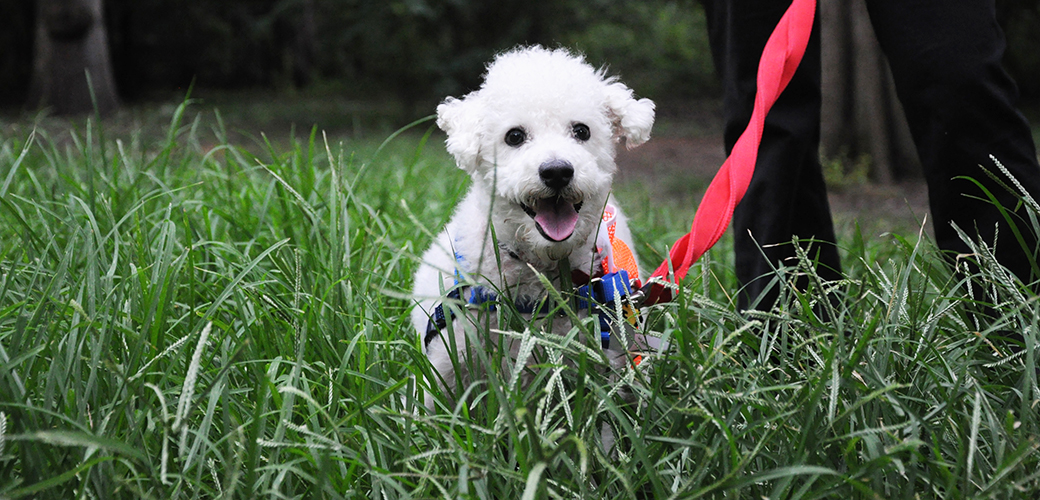Can Humans Get Fleas from Dogs?

More than 60 percent of households in the United States have pets, and half of the dogs get to share their beds with people. With our furry family members living in such close quarters with us, we are at greater risk for catching diseases from our pets, known as zoonotic diseases.
While several of these creepy crawlies have had their time in the media spotlight, what about the common flea? Can humans get fleas from their pets? Find out the answer to that question and what you can do about it.
Can Humans Get Fleas From Their Dogs?
Yes, humans can get fleas from their dogs and other pets. If you’ve ever walked across the carpet and noticed a dark speck on white socks that suddenly appears then vanishes, that speck probably was a flea.
While pets undoubtedly enrich our lives in innumerable ways, this close proximity has put us at greater risk for sharing ectoparasites, such as the flea. But don’t fret just yet; the possibility of getting fleas yourself is not reason to put your pup in the dog house.
Make a Tug Toy From Old Clothes. Does your dog love to play tug? Got some extra t-shirts lying around? Make your own toy by braiding one of your old t-shirts into a tug toy rather than throwing them out.
There are thousands of species of fleas, and most animals have a specific flea species that prefers that animal as its host. While the flea that dogs typically carry can—and do—jump over to humans and bite us, the dog flea cannot survive on humans.
First, dog fleas need dog blood to eat. Second, humans aren’t hairy enough to provide ample hiding coverage or the warm environment that dog fleas seek in a home.
Most fleas figure this out quickly and will return to your pup or seek a safer spot in your home. This makes treating your home a key part of flea prevention and treatment not to overlook.
What to Do If You Spot Fleas
Flea bites—and fleas—are pretty distinctive. If you see dark small bugs that hop, instead of flying, and find yourself with bites, it is most likely fleas.
Unlike mosquito bites, flea bites remain small. If a flea bites you, you might see one or more of the following:
- bites that appear as small, red bumps
- a red “halo” around the bite center
- bites in groups of three or four, or in a straight line
- bites that appear around the ankles or legs
In humans, flea bites do not require specific treatment. Washing the area with soap and water, applying anti-itch cream as necessary, and avoiding the temptation to scratch will lead to quicker relief and healing.
Train your dog for a lifetime of obedience. Behavior problems are the number one reason dogs are relinquished to animal shelters, the number one reason they don’t find new forever homes, and as a result, the number one reason dogs are euthanized.
In dogs, however, apart from irritation, fleas can lead to hot spots or cause anemia in heavy infestations, especially in young or debilitated dogs. In addition, certain fleas can carry several diseases, including the bubonic plague, and act as vectors to spread one of the most common tapeworms of the dog and cat.
While this can sound alarming, remember fleas on humans for more than a bite or two are rare. If you do spot fleas on yourself or your dog, it is best to initiate treatment right away and get a fecal exam for your dog.
READ ALSO:
10 Tips for First-Time Dog Owners
Flea Treatment for Pets
Dogs and cats can share the same fleas, so it is important that all pets in your home are on a flea preventive. Treating your pets for fleas has never been easier, and many options are available for pets of all ages, as well as for your home, which range from do-it-yourself flea bombs to hiring professional exterminators.
How do I prevent fleas on my dog?
Successful flea control starts with prevention. Popular vet-recommended options for cat and dog flea treatments include Frontline Plus, Seresto and K9 Advantix II.
Move over Rover! 45% of dogs sleep in their owner’s bed (we’re pretty sure a large percentage also hog the blankets!)
What about my home environment?
Environmental preparations for flea control are becoming increasingly sophisticated. Remember, however, that most products are effective against only the adult flea.
Products that contain Insect Growth Regulators (IGR) will help destroy the flea eggs and larvae. Before applying any environmental product, vacuum all floors to stimulate the pre-adult fleas to emerge from their protective cocoons. And be sure to discard the vacuum cleaner bag after its use.
My dog mostly lives outside. What should I do?
READ ALSO:
Fleas and Ticks
Fleas prefer tall grass and shaded areas near decks, woodpiles or storage buildings, so concentrate on these areas. Spray a product containing an IGR and repeat every 14-21 days for three to five applications.
The fleas came back! Why? What did I do wrong?
Before fleas reach their adult stage, they can survive within a cocoon for up to nine months. During this time, they are resistant to insecticides applied to the environment. This is important to remember because adult fleas may emerge into the environment a considerable time after you apply insecticides in your home.
Use a Window Squegee to Clean Up Fur From Carpet. Do you get a ton of dog hair lodged deep into your carpet? Use a window squegee to pick up fur in your carpet & on your furniture. Scrape it along the carpet & just watch as that hair comes up.
Sharing your home and heart with your four-legged family means that when your dog has fleas, the pests likely will try to bite you, too. Keep dogs and cats free of fleas and flea bites by administering prevention medication year-round and taking flea treatment seriously at the first sign.
By: Dr. Laci Schaible, DVM, CVJ
Featured Image: Via iStock.com/AfricaImages















